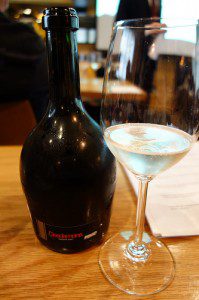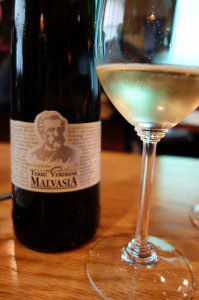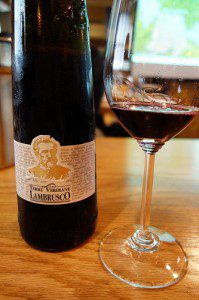19 Jun Italian Wine Focus: Prosciutto di Parma and the Wines of Emilia Romagna
Seminar 4: Prosciutto di Parma and the Wines of Emilia Romagna
In every region in Italy, there are specialty food products as well as the wines produced. So of course the ideal way to taste wines is paired with one of these local products. For the most recent wine seminar from the North American Sommelier Association, the wines of Emilia Romagna were paired with Prosciutto di Parma. Yum!
Emilia Romagna is known for Ferrari, Lamborghini, Maserati, Ducati and Bugatti; it is home to the world’s oldest university in Bologna and is the cultural and political link between the North and the South. Emilia Romagna is also known for Parmigiano Reggiano, Balsamic Vinegar from Modena, Prosciutto di Parma and Lambrusco.
The Consorzio of Prosciutto Di Parma was established in 1963 by 23 producers who wanted to protect and promote their product throughout the world. Since then, production has been regulated by strict laws defining the quality characteristics of Prosciutto di Parma, identified by the Parma Crown branded on the ham. The Consorzio promotes and protects the brand worldwide, provides technical assistance and ensures compliance by breeders, slaughter houses, producers and point of sale.
Did you know?
- There are 164 producers who supply 10 million prosciutti annually all over the world
- Prosciutto di Parma can be produced only in the gently rolling hills on Langhirano, south of Parma
- Pigs are selected and supplied by 550 breeding farms and 120 slaughterhouses
- Pigs are 9 months old and 350 pounds
- There are only 3 breeds of pigs used
- Pigs can be farmed from 11 different regions but the work must be done in Parma
- There are only 4 ingredients in Prosciutto di Parma – Pig breed, sea salt, air and time
- Prosciutto di Parma is 100% natural – no nitrites, no water, no smoking allowed
- After the pork legs reach the prosciuttificio (processing plant), salting is done by hand in the traditional way by the Maestro Salatore, the Salt Master
- Curing lasts 100 days in climate controlled refrigerated rooms to ensure the meat absorbs the salt
- Once cured, the legs are rinsed and moved to large airy rooms where windows are opened for the aromatic breezes coming from Apennine Mountains that help dry and cure the hams and impart a special flavor
- Aging is a minimum of 4 months
- After 4 months, the exposed surfaces of the meat are coated with lard to soften them and help control the loss of moisture
- Final aging lasts a minimum of 5 months
- Gradually the hams lose about 30% of their total weight, which helps concentrate flavor
- Final test – after 400 days, there is a quality check. Inspector pierces the ham in several locations with a horse bone needle, sniffing it after each puncture. Only hams that meet the highest standards get the seal of approval. The ham must possess a rich, sweet, salty fragrance.
- All legs that pass the quality check are fire branded
- Each leg has complete traceability as each production step, from the breeding of the pigs to the processing to the final packaging is monitored and controlled
As for the wines of Emilia Romagna, the region is divided into two distinct provinces: Emilia and Romagna. Emilia occupies the western sector, while Romagna lies to the east of Bologna and stretches all the way to the Adriatic Sea. In total there are 22 DOCs in Emilia-Romagna and two DOCGs (Albana di Romagna and Colli Bolognese Classico Pignoletto).
Grapes of Emilia: Pignoletto, Pinot Bianco, Riesling Renano, Bobmino Bianco, Mountu, Malvasia Bianca di Candia Aromatica, Sauvignon Blanc, Chardonny, Lambrusco (Salamino, Sorbara, Grasparossa), Croatina (bonarda), Barbera
Grapes of Romagna: Sangiovese, Trebbiano and Albana
Cantine Ceci Desdemono DUCATI Spumante Extra Dry Emilia IGT NV (Malvasia, Pinot Bianco) – A joint venture between winery and Ducati, this wine is clear, light straw color, persistent bubbles, crisp, bright, sharp
Castello di Luzzano Deta Malvasia Colli Piacentini DOC 2011 – Straw yellow to light gold in color, floral nose, silky with acidity on sides of palate
Cantine Ceci Terre Verdiane Malvasia Frizzante Emilia IGT NV – Minerality, floral, fruity, herbacious, acidity
One of the most famous wines from Emilia Romgna is Lambrusco, the lightly sparkling red or pink wine produced around Modena and Reggio near the Po River. There are 6 clones of Lambrusco (grasparossa, maestri, marani, montericco, salamino and sorbara) and 5 DOCs, including Lambrusco Grasparossa di Castelvetro, Lambrusco Salamino di Sante Croce, Lambrusco di Modena and Lambrusco di Sorbara. Lambrusco is light in tannins, light body, low alcohol, crisp and zesty acidity, refreshing, lively sparkle, fragrant bouquet fruity and floral (raspberry, cherry, violet, carnation, rose).
Cantine Ceci Terre Verdiane Lambrusco Secco Frizzante Emilia IGT NV – purple red with notes of blackberry and plum, the wine is medium dry and velvety
Cantine Ceci Terre Verdiane Lambrusco Amabile Frizzante Emilia IGT NV – deep ruby red with notes of wild strawberry and violet
Discover more from Please The Palate
Subscribe to get the latest posts sent to your email.










